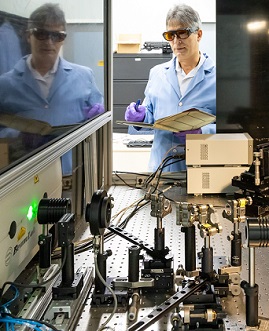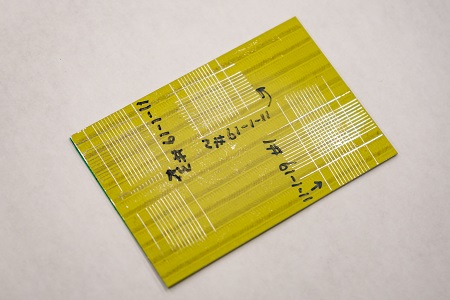
Laser Treatment Reduces Need for Hazardous Chemicals in Coatings Prep
Although highly regulated, the chemical pre-treatment processes used to prepare U.S. Department of Defense materials for protective coatings involve hazardous compounds that can harm one’s health and the environment. A laser-interference structuring (LIS) system developed by the Department of Energy’s Oak Ridge National Laboratory (ORNL) could make protective coating application safer and more sustainable, by substantially lessening the need for these hazardous chemicals.
Materials scientist Adrian Sabau and his team demonstrated and analyzed an LIS technique and compared its performance to traditional solvent-intensive pre-treatment methods. The team had previously used LIS for bonding in automotive applications, and thought that a similar technique could be effective for coating adhesion.
The researchers tested two-beam laser-interference processing on aluminum alloy sheets. They split the primary beam of a pulsed nanosecond laser into two beams and focused the beams on the same spot on the surface of the sheets. This process roughened the aluminum surfaces, which changed the surface chemistry and the subsurface microstructure.
The team investigated the surface chemistry and subsurface microstructural changes using laser interferometry produced by the two beams of the pulsed Nd:YAG laser. The two-beam laser-interference allowed the structuring of the surface at length scales much less than that of the laser beam spot.

ORNL scientist Adrian Sabau and his team developed a laser-interference structuring system that was used to treat aluminum alloy sheets for corrosion protection. Courtesy of Carlos Jones/ORNL, U.S. Department of Energy
Using x-ray photoelectron spectroscopy (XPS), physical chemist Harry Meyer next conducted a surface chemical analysis of the aluminum alloy sheet. XPS data indicated that the aluminum oxide layer had been modified, compared to that of the baseline specimen, and that the oxide thickness had increased with the number of shots per spot. Most of the surface organic and inorganic contaminants were removed.
“Before laser processing, XPS was used to determine the chemical composition of the as-received aluminum alloy sheets, which showed high amounts of carbon,” Meyer said. “XPS was used again to determine if the laser processing cleaned the surface. The result showed a significant reduction of the carbon.”
XPS, with electron microscopy results, helped the team understand how the original oxide was altered through laser processing. Near surface microstructural changes to the aluminum alloy were investigated with scanning electron microscopy and energy dispersive x-ray spectroscopy (SEM/EDS). SEM microstructure pictures of the top surface showed that the sharp features from a rolled sheet surface were smoothed by laser-structuring. Subsurface characterization revealed dissolution of copper-rich precipitates, a potential cause of corrosion.
To test coating adhesion, the researchers performed coating adhesion tests on a primer that was coated on LIS surfaces of aluminum sheets, without the use of polishing, cleaning, or other surface alteration techniques. They also conducted profilometry tests on the sheets to map surface contours and provide roughness measurements.
The team found that the laser-processed aluminum had a higher or identical ranking for coating adhesion than those prepared with current state-of-the-art chemical conversion or sulfuric acid anodizing. A patent for coating adhesion was awarded in 2021 based on the team’s LIS technique.

A primer-coated specimen shows marks from the laser system. Courtesy of Carlos Jones/ORNL, U.S. Department of Energy.
After storing the aluminum samples in plastic cases for up to 70 days without any additional cleaning, the researchers spray-coated the samples with primers and topcoats that had been prepared using LIS, chromate conversion coating (CCC), and sulfuric acid anodizing (SAA) treatments. To track corrosion resistance over time, the researchers exposed the samples to 2000 hours of salt spray. The corrosion behavior of LIS specimens was assessed against that of specimens prepared using CCC and SAA treatments.
“The laser interference-treated substrate exhibited higher corrosion resistance,” said researcher Jiheon Jun, who attributed the result to copper-rich precipitates dissolving. However, on the samples coated with primer or primer and topcoat, LIS did not perform as well as the chemical solvent techniques, with some samples showing blisters within 96 hours of salt spray exposure. However, the blisters were small and remained stable through hundreds of hours of exposure.
The team tested a second set of samples that were simply wiped down with acetone prior to the application of primer. This approach resulted in very little corrosion, and the formation of blisters was delayed by hundreds of hours.
Results indicate that the LIS technique — with the additional acetone wiping — has the potential to be further developed as a nonchemical surface preparation technique for chromate-containing epoxy primer coating systems.
“Our research approach, combining lab-scale electrochemical measurements and industrially adopted ASTM [American Society for Testing Materials] salt spray testing, was very successful and aided in-depth understanding of the effects of laser interference treatment,” Jun said.
“For a process that was conducted at ambient temperature without solvents, most of the samples performed extremely well,” Sabau said. “This technique is a huge step in the right direction towards nonchemical intensive surface preparation for coatings.”
The research was published in three journals. Development and testing of the LIS process appear in Optics & Laser Technology (www.doi.org/10.1016/j.optlastec.2020.106457).
Results of testing coating adhesion on LIS surfaces were published in the International Journal of Adhesion and Adhesives (www.doi.org/10.1016/j.ijadhadh.2020.102641).
Results of testing the corrosion resistance of the LIS-prepared materials were published in CORROSION: The Journal of Science & Engineering (www.doi.org/10.5006/3717).
Published: September 2021